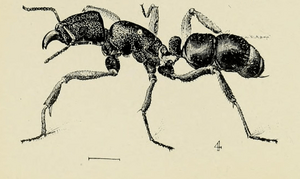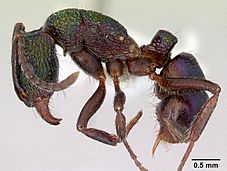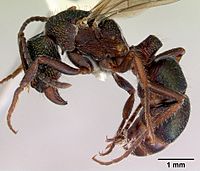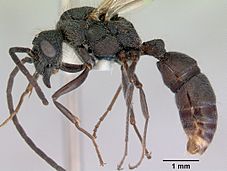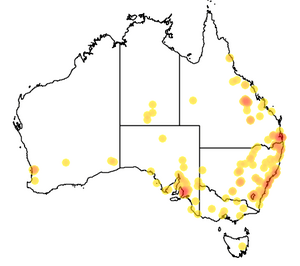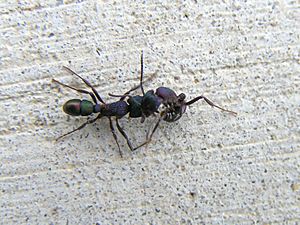Green-head ant facts for kids
Quick facts for kids Green head ant |
|
|---|---|
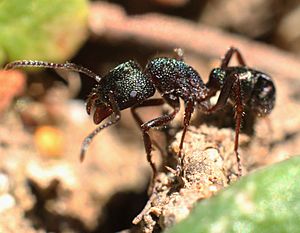 |
|
| Worker from Newcastle, New South Wales | |
| Scientific classification | |
| Kingdom: | |
| Phylum: | |
| Class: | |
| Order: | |
| Family: | |
| Subfamily: |
Ectatomminae
|
| Genus: |
Rhytidoponera
|
| Species: |
R. metallica
|
| Binomial name | |
| Rhytidoponera metallica (Smith, 1858)
|
|
| Synonyms | |
|
|
The green-head ant (Rhytidoponera metallica) is also known as the green ant or metallic pony ant. This ant species lives only in Australia. A British scientist named Frederick Smith first described it in 1858.
These ants are usually between 5 to 7 mm (0.20 to 0.28 in) long. The queens and workers look quite similar, but queens are a bit bigger. Males are the smallest. Green-head ants are famous for their shiny, metallic look. Their colors can range from green to purple or even reddish-violet.
These ants are very common across Australia, found in almost every state except Tasmania. They have also been brought to New Zealand, where they have started new groups.
Green-head ants live in many places, like deserts, forests, woodlands, and even cities. They build their nests underground, often under logs, stones, or shrubs. Sometimes, they live inside old wooden stumps or even in termite mounds. They are among the first insects to appear in areas after a bushfire. Light rain doesn't bother their colonies if the sun is still shining.
These ants are active during the day. They hunt small insects and other arthropods. They also collect sweet liquids like honeydew from sap-sucking insects. Green-head ants help spread seeds by carrying them around. Animals like the short-beaked echidna and various birds eat them.
Green-head ant workers can reproduce with winged males. This means the queens are not as important, and colonies rarely produce them. Mating flights happen in spring. New colonies can form when a queen starts her own nest and finds food for her young. Colonies can also grow by "budding," where a part of the colony moves to a new nest site.
The sting of a green-head ant can be painful and contains venom. For some people, it can cause a serious allergic reaction. However, these ants can also be helpful. They act as natural pest control by eating insects like beetles, moths, and termites that harm crops.
Contents
Ant History: How Green-Head Ants Got Their Name
The green-head ant was first described in 1858 by Frederick Smith. He named it Ponera metallica. He found two samples, a worker and a queen, in Adelaide, South Australia. These samples are now kept in the Natural History Museum in London.
Later, in 1862, another scientist named Gustav Mayr moved the ant to a different group called Rhytidoponera. Over the years, scientists sometimes got confused about its exact classification. In 1897, Carlo Emery finally named it Rhytidoponera metallica, which is its current scientific name.
Scientists used to be confused because green-head ants look different in various places. Also, some similar-looking ants were mistakenly called different types of green-head ants. In 1958, William Brown Jr. studied these ants closely. He realized that several different names given to similar ants were actually all the same species. For example, ants that looked purple were just a color variation of the green-head ant.
Today, the green-head ant belongs to the Rhytidoponera group. This group is part of the larger ant family called Formicidae. Ants are insects that belong to the order Hymenoptera, which also includes bees and wasps. Besides "green-head ant," people in Queensland sometimes call it the "metallic pony ant" or "green ant." But be careful, because in northern Queensland, the green-tree ant is also called a "green ant"!
What Do Green-Head Ants Look Like?
Green-head ants usually come in one main shape, measuring 5 to 7 mm (0.20 to 0.28 in) long. Their color can be green-blue to green-purple. They have a hard, armored outer shell and a single-segmented waist.
Queens are about 7.4 mm (0.29 in) long. Their heads, bodies, and abdomens show different metallic colors. The head is often green behind the eyes and reddish-brown in front. Their eyes are oval-shaped. The queen's head, body, and the segment between her body and abdomen are rough and covered with small dents. Her abdomen has curved grooves. The body is usually greenish, and her wings look glassy. Her legs and the tip of her abdomen are reddish-brown, and her abdomen is purple.
Workers and queens look very much alike, making them hard to tell apart. However, workers have a more stretched-out body and an abdomen that is mostly green. Workers are also a bit smaller than queens, usually 6 mm (0.24 in) long.
Males are smaller than both workers and queens, measuring about 5.5 mm (0.22 in). They appear dark and dull. Their legs are dark, and their jaws are rough. Unlike workers and queens, the males have shorter antennae parts. Their heads and bodies are more densely textured, and they have fewer dents. The first part of their abdomen is rough across. The hairs on their legs are less dense.
The main metallic color is green, but it can change depending on where the ants live. In places like the Flinders Ranges in South Australia and Alice Springs, the ants are dark purple instead of green. In areas with more rain, like parts of New South Wales, they are mostly green with purple hints on their sides. In northern New South Wales and Queensland, their upper body can be reddish-violet, sometimes with golden parts. The green color might be very limited or even missing in these areas. Most green-head ants have a bright green abdomen, except for those in the central desert.
Sometimes, two different color forms have been found in one colony near Brisbane. This might mean they are two very similar species, but more proof is needed. Ants in far north Queensland look dull green and are different from those in the south. It's not known if these northern ants are a different species. Besides color, their body shapes can also vary. For example, the size and shape of their heads and the length of their legs can be different.
Young larvae are about 1.5 mm (0.059 in) long. They look similar to older larvae but are much smaller. The hairs on their bodies are short.
Where Do Green-Head Ants Live?
The green-head ant is one of the most common insects found only in Australia. You can find them across Victoria, New South Wales, the Australian Capital Territory, and South Australia. They are also in most parts of Western Australia, but less common in the north. You can find them in the southern Northern Territory and eastern Queensland. They do not live in Tasmania.
Green-head ants were brought to New Zealand by accident, first seen in 1959. They likely arrived on timber shipments. They have set up groups in Napier. Nests were also found in Auckland and Mount Maunganui in the past, but no ants have been collected there since the 1960s.
These ants live in many different places, including deserts, open forests, and even cities. They are very common in lawns and gardens in towns. Their nests have been found in dry and wet woodlands, and along roadsides. Green-head ants are usually found at heights between 5 and 1,000 m (16 and 3,281 ft) above sea level.
Workers build small nests underground or inside rotting wooden stumps. They might also nest in the termite mounds of Amitermes laurensis. Their nests are often under grass roots, logs, stones, or at the bottom of shrubs. Because they can nest in disturbed areas, you often see them in cities. They are among the first insects to look for food after bushfires, sometimes returning right after the smoke stops. Light rain doesn't harm them if the sun is still out.
Green-Head Ant Behavior and Life
Green-head ant colonies choose their nest locations carefully. Some prefer larger rocks over smaller ones, as bigger rocks help the colony grow better. A growing colony needs more space for its members and young. However, these ants don't pick rocks based on thickness or temperature. They choose based on how much ground the rock covers. They also don't move very far to find a new home, usually no more than 3 metres (9.8 ft). This suggests that moving to a better spot costs a lot of energy, so they only do it if it's really worth it.
Colonies sometimes abandon their nests, especially in summer. During colder months, ants are less active. This might be why they leave nests more often in summer. Other ant species usually don't take over abandoned green-head ant nests. The reasons for leaving a nest are likely related to food availability and competition with other nearby colonies.
Hunting, Food, and Predators
Green-head ants are active during the day. They quickly search for food on the ground or on plants. They are scavengers, hunters, and seed-eaters, meaning they eat many different things. Their diet includes animal material, insects, small arthropods, honeydew (a sweet liquid from sap-sucking insects), and seeds. Workers often hunt beetles, moths, and termites. They use their stingers to inject venom and kill their prey.
Green-head ants are not bothered by the presence of dominant ants like the meat ant. They can still find food successfully. Since green-head ants hunt alone and don't usually work in large groups to defend food, they tend to live peacefully alongside other dominant ant species.
Studies show that what green-head ants eat can affect how long they live. Colonies given a balanced diet with honey-water and flies had more young and fewer worker deaths compared to those on a less suitable diet.
These ants also eat seeds. They prefer seeds that are easy to open. They collect and spread seeds from several types of Acacia trees, like the myrtle wattle and golden wattle. Green-head ants move almost half of the seeds they eat about 60 to 78 centimetres (24 to 31 in) away from their nests. Some seeds, like those from Adriana quadripartita, are moved even farther, up to 1.5 metres (59 in). Seeds moved by green-head ants have a better chance of surviving than those collected by other ants. However, seeds inside green-head ant nests rarely sprout.
The size of a colony affects how far and how long workers search for food. Workers from smaller colonies travel shorter distances and spend less time outside. Those from larger colonies spend more time outside and go farther from their nest. This might help smaller colonies save energy and reduce the risk of being eaten by predators.
Green-head ants usually hunt alone. They rarely call other ants to help. However, if a worker finds a lot of food, it might leave a scent trail to help other ants find it. This behavior increases when they find large prey, suggesting they want to attract more nestmates to help carry it. But for smaller prey, they might leave less scent to make transport faster. Workers can quickly change their foraging behavior based on the quality of the food.
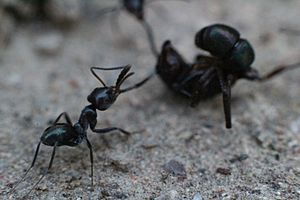
In large green-head ant colonies, older workers usually go out to find food, while younger workers stay inside and care for the young. This is called age caste polyethism. In smaller colonies, both young and old workers do nursing and foraging. This shows that age itself isn't the only reason for job roles. Instead, it's more about how many ants are in the colony.
Green-head ants are eaten by several animals. These include assassin bugs and the short-beaked echidna. Birds like the Australian white ibis, black kite, and masked lapwing also eat them. Sometimes, parasites can infect workers and larvae. Certain beetles, like Chlamydopsis longipes, are sometimes found living inside green-head ant colonies.
Life Cycle and Reproduction
Male green-head ants are born throughout the year and fly low to the ground. Mating flights usually happen from September to November when temperatures are between 20–25 °C (68–77 °F). During this time, many males leave their nests. Sometimes, males return to their nest after a short flight.
Green-head ants are a "gamergate" species. This means that male ants can successfully mate with worker ants. When a male and worker meet, the worker might first attack the male. Then, the male will grab the worker's neck with its jaws and mate.
It's rare to find virgin queens in green-head ant colonies. Some nests might produce winged females, but these queens are rarely seen starting new colonies in the wild. This suggests that the green-head ant species might be losing its queen caste. Most observations show males mating with workers, not queens. This means workers are taking over the role of reproduction.
New colonies are often started by a fertilized worker. This worker will stay in a closed cell and lay eggs. Sometimes, she will leave to find food. However, in lab settings, colonies started by workers only produced males. This suggests that new colonies might form when a group of workers, including some fertilized ones, leave their original nest. This process is called "budding." Even though queens are rare, they might still help spread the species over long distances. Colonies start small but can grow quickly to become mature.
Genetic studies show that green-head ant workers mate with males from other, unrelated colonies. The workers within a nest are also not very closely related. Many worker ants in a colony can reproduce. If these reproducing workers are not related, a nest can have as many as nine of them. All of them help produce young. In many colonies, workers prevent other young females from reproducing.
Green-Head Ants and People
The green-head ant has a very strong sting that can be painful, but the pain usually doesn't last long. You can use an icepack or a special spray to help with the pain. However, if someone has an allergic reaction, they should go to the hospital. The venom is strong enough to cause a serious allergic reaction called anaphylactic shock in sensitive people.
A 2011 study in Australia looked at which native ants caused allergic reactions. It found that 34 people reacted to the green-head ant's venom. Most other people in the study reacted to the venom of Myrmecia ants, especially the Jack jumper ant. The study concluded that four main groups of Australian ants cause serious allergic reactions. The green-head ant was the only one that was not a Myrmecia species to cause these reactions.
Green-head ants have also been reported to cause deaths among poultry (farm birds). But even with these dangers, green-head ants can be helpful. They act as a natural way to control pests. They kill insects that harm crops, such as beetle and moth larvae, and termites.


